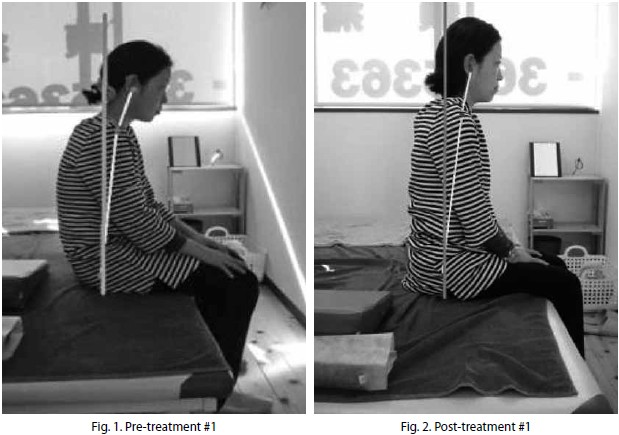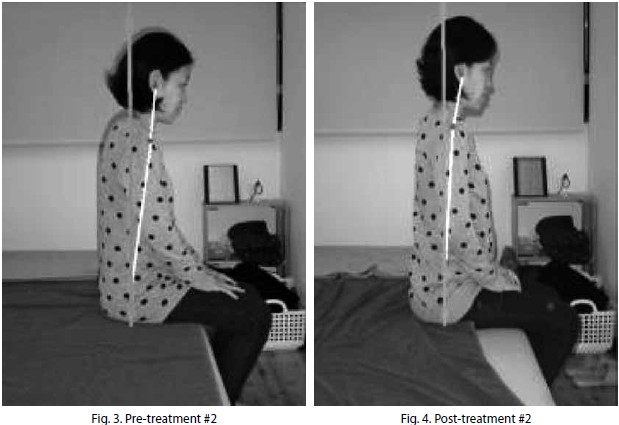Genta Niikura
Clinic Director, Genta Chiryoin
Abstract : In clinical practice, one encounters many patients presenting subjective symptoms of shoulder stiffness or back pain. Here we examine a case in which symptoms were alleviated through posture and joint correction, in addition to using shiatsu therapy to reduce muscle tension. By combining the pressure applications of shiatsu therapy with mobilization, it was possible to achieve an effect on both muscles and joints.
Keywords: shiatsu therapy, pressure application, exercise therapy, posture correction
I.Introduction
In clinical practice, one often encounters patients for whom, even though muscle tension is alleviated through shiatsu therapy consisting of pressure application to muscles and soft tissues, similar symptoms return after several days or weeks.
It was our opinion that these symptoms could be more effectively treated with a combination of shiatsu therapy and ongoing posture correction and joint adjustment.
Here, we report on a case in which significant therapeutic effect was achieved through joint adjustment and posture correction via the use of pressure applications combined with mobilization.
Ⅱ.Methods
Subject
Female child care worker in her 30s
Location
This clinic (Genta Chiroin)
Period
March 30 to April 12, 2014
Primary complaint
Work involves frequent crouching, leading to lumbar pain, stooped posture, and severe shoulder stiffness; patient told by coworkers that she has poor posture
Treatment method
Full body shiatsu 1 combined with mobilization for shoulder, hip, and sacroiliac joints
- For rounded back:
Prone position: Palmar pressure to spine, spinous process adjustment - For internal rotation of shoulder joints:
Lateral position:
Pressure applications to superior angle of scapula, sub-clavicular region, and coracoid process, plus adjustment procedure to scapula - For Lumbar kyphosis:
Supine position: Palmar pressure to abdomen and inguinal region
Prone position: Adjustment of hip and sacroiliac joints - For posterior pelvic tilt:
Supine position: Palmar pressure to abdomen and inguinal region
Prone position: Adjustment of hip and sacroiliac joints
III.Results
Treatment #1 (March 30, 2014)
Pre-treatment findings
Subjective findings
- Work involves frequent crouching, leading to lumbar pain, stooped posture, and severe shoulder stiffness; patient told by coworkers that she has poor posture Objective findings
- Exaggerated posterior pelvic tilt, rounded back, exaggerated internal rotation of shoulders (Fig. 1)
Post-treatment findings
Subjective findings
- Reduced sensations of shoulder stiffness and lumbar pain; reduced discomfort at work, even after maintaining same posture for a prolonged period
Objective findings
- Tension in lumbar musculature reduced due to creation of anterior pelvic tilt and lumbar lordotic curve; reduced internal rotation of shoulders due to improved shoulder posture (Fig. 2)
Treatment #2 (April 12, 2014)
Pre-treatment findings
Subjective findings
- Patient told by those around her that her posture had improved; alleviation of lumber pain
Objective findings
- Anterior pelvic tilt maintained; exaggerated internal rotation of shoulders observed (Fig. 3)
Post-treatment findings
Subjective findings
- Alleviation of symptoms of shoulder stiffness and lumbar pain; reduced discomfort, even after maintaining same posture for a prolonged period
Objective findings
- Improvement of exaggerated internal rotation of shoulders (Fig. 4); alleviation of muscle tension due to adjustment of joint position
IV.Discussion
According to the Comprehensive Survey of Living Conditions by the Japanese Ministry of Health, Labour and Welfare 2, the two most common symptoms experienced by both men and women in Japan are, in order, stiff shoulders and lumbar pain. Little has changed in this situation, and a comparatively large number of patients visiting our clinic list stiff shoulders or lumbar pain as their primary complaint.
It is my experience in a clinical setting that, in order to alleviate shoulder stiffness or lumbar pain, effects are longer lasting if reduction of excess muscle tension is used in combination with joint adjustment.
The reason is that, as humans are bipedal, they must continually maintain posture in opposition to gravity. The extensors, trunk muscles, and other antigravity muscles must maintain contraction in order to resist gravity and maintain proper posture, which when disrupted is corrected by postural reflexes 3. It follows that a greater load is placed on these muscles when proper posture and skeletal alignment are regularly disrupted during routine daily activities. For this reason, correction of chronically disrupted postural and skeletal alignment should help alleviate symptoms of shoulder stiffness and lumbar pain.
In this case, initial examination revealed marked postural disruption from the line of gravity (Fig. 1), indicating probable hypertonus in the pectoralis major and other shoulder internal rotator muscles along with reduced tonus of the antigravity muscles. Also, hypertension in the gluteus maximus and hamstring muscles were likely responsible for the posterior pelvic tilt.
In the initial treatment, hypertonus in the gluteus maximus and hamstrings was improved, along with overextension of the quadratus lumborum and erector spinae muscles, as was evidenced by the reductions in posterior pelvic tilt and lumbar kyphosis. Also, concerning the shoulder joints, changes to the position of the scapula were likely due to reduced hypertonus in the internal rotators, including the pectoralis major, latissimus dorsi, and subscapularis (Fig. 2).
Prior to treatment #2, a slight internal rotation of the shoulder joints was observed, though no major postural disruption from the line of gravity compared to post-treatment #1 was apparent (Figs. 2, 3). In treatment #2, further improvements to pliability in hypertoned muscles improved balance with over-extended muscles, causing positional changes to the shoulder joint and humerus that likely resulted in reduced tension in the trapezius, sternocleidomastoid, and other neck muscles that led to improvements in head position.
It is difficult to determine whether disrupted posture due to routine daily activities led to muscular hypertonus and hypotonus or whether the problem was due to irregularities in joint alignment, but since multiple reports have shown that shiatsu stimulation effectively increases muscle pliability 4-6, in this case it is likely that pressure application relaxed hypertoned muscles that were the cause of postural disruption while mobilization improved joint positioning, resulting in alleviation of symptoms.
V.Conclusions
When the pressure applications of shiatsu therapy are combined with mobilization, there is a tendency for symptoms of stiff shoulders and lumbar pain to be alleviated due to elimination of muscle hypertension and improved joint positioning. However, because this report only contains one example, it will be necessary to study a larger number of cases.
VI.References
1. Ishizuka H: Shiatsu ryohogaku, first revised edition, International Medical Publishers, Ltd. Tokyo, 2008 (in Japanese)
2) 2. Japanese Ministry of Health, Labour and Welfare: Kokumin seikatsu kiso chosa. 2013, http://www.mhlw.go.jp/toukei/list/20-21.html (in Japanese)
3. Toyo ryoho gakko kyokai: Seirigaku. Ishiyaku shuppan KK, 1990 (in Japanese)
4. Asai S et al: Effects of Shiatsu Stimulation on Muscle Pliability. Toyo ryoho gakko kyokai gakkaishi (25): 125-129, 2001 (in Japanese)
5. Sugata N et al: Effects of Shiatsu Stimulation on Muscle Pliability(Part2). Toyo ryoho gakko kyokai gakkaishi (26): 35-39, 2002 (in Japanese)
6. Eto T et al: Effects of Shiatsu Stimulation on Muscle Pliability(Part3). Toyo ryoho gakko kyokai gakkaishi (27): 97-100, 2003 (in Japanese)


